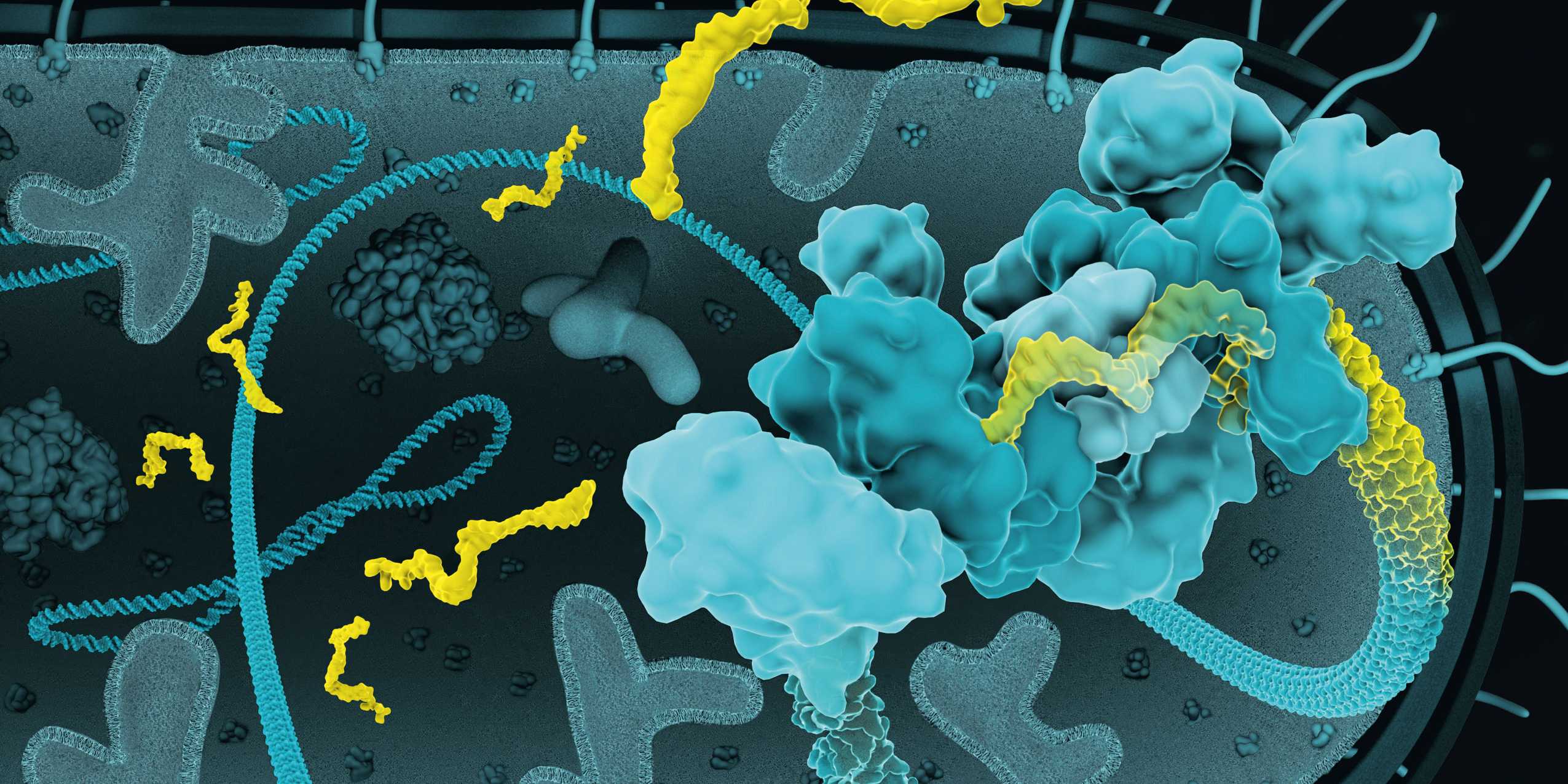Combatting infant malnutrition
Bioengineer Randall Platt engineers bacteria that can assess the state of our guts. It is hoped this non-invasive technique could eventually be used to develop more effective interventions against malnutrition among children in the Global South.

According to the World Health Organisation (WHO), 148 million children under five suffer from developmental delay due to malnutrition and are therefore unlikely to reach their full potential as adults. Malnutrition is caused by an insufficient intake of food or an inadequate absorption of nutrients such as proteins, vitamins and minerals. This, in turn, stunts growth and weakens the immune system. Infant malnutrition is a problem chiefly in Africa and Asia.
In Zimbabwe, decades of political and economic turmoil have had a profound impact on health. Outbreaks of typhus, measles and cholera are common – and children are the worst affected. UNICEF estimates that some 2 million children in Zimbabwe were dependent on humanitarian aid in 2023. “Many of the mothers I work with have access to running water for only three hours a day,” says Kerina Duri, a professor of immunology at the University of Zimbabwe. “And a fifth of these women live on less than one US dollar a day.”
The role of gut flora
Five years ago, Duri established a cohort of 1,200 mother-child dyads and launched a research study that is still ongoing today. The mothers live in densely populated areas of Zimbabwe’s capital Harare. Many of them are infected with AIDS, and malnourishment is common among their children. One of Duri’s main goals is to understand why newborns who are exposed to HIV during pregnancy and the breastfeeding period, yet remain uninfected, are nevertheless at a higher risk of dying young. “There’s a lot of evidence to suggest that the answer might lie in the newborn’s gut flora,” says Duri. “If a mother takes antiretroviral medications to suppress AIDS, her baby’s gut flora will be exposed to these drugs during breastfeeding – and that could have a negative impact on the child’s physical, neurocognitive and social development.”
Gut flora, also known as gut microbiota, are the microorganisms that reside in the digestive tract – and Duri notes that Zimbabwe still lags far behind when it comes to research and expertise in this area. She is therefore pinning her hopes on a joint project with the Basel Research Centre for Child Health (BRCCH). Founded by ETH Zurich in collaboration with the University of Basel and charity group Fondation Botnar, the BRCCH aims to develop effective medical interventions for children in the Global South. Since 2020, Duri has been working with colleagues at the University of Bern, the University of Basel and ETH Zurich as part of a project funded by the BRCCH. Their goal is to improve diagnostic methods of assessing gut flora in infants.
About
Randall Platt is Professor of Biological Engineering in the Department of Biosystems Science and Engineering at ETH Zurich and in the Department of Chemistry at the University of Basel.
Sensor bacteria
At the helm of the five-year project is 36-year-old Randall Platt, Associate Professor of Biological Engineering at ETH Zurich. Last October, his research group moved into the new building of the Department of Biosystems Science and Engineering in Basel, where light floods through the windows of his office. “We still don’t have any simple methods of reliably measuring inflammation, infection and diet-related gut disorders, even though we know that gut microbiota are central to human health,” says Platt. The bacteria in our intestines influence almost all organs, including the brain, he adds, and they play an important role in the immune system and metabolism.
Currently, the standard method of assessing gut composition and health is by means of a colonoscopy. This is not an entirely straightforward procedure, and it is very unpleasant for patients – especially since the bowels need to be completely emptied beforehand. Moreover, the results are merely a snapshot of the manipulated colon at a given moment, with no measurement of changes over time. These drawbacks prompted Platt to come up with a more elegant alternative. His technique is non-invasive and does not disturb normal intestinal function, yet it still provides insights into changes in the gut environment. “It’s a huge technological leap – a bit like switching from photography to film,” says Platt.
The recording tools used by Platt and his team are just a few micrometres in size. They consist of E. coli bacteria modified using the CRISPR-Cas system in such a way that they can identify and record changes in their biological environment. “The cells of these bacteria adapt to their environment as they pass through the intestine. They react to changes in pH as well as to nutrients and chemicals,” Platt explains – and these reactions can be measured. At the genetic level, the researchers capture RNA molecules in living E. coli to determine the genes expressed by the bacteria in response to the gut environment. The researchers encode this collection of gene expression events like a digital video camera, storing them on a kind of bacterial memory card. To do this, they isolate bacterial DNA from a faecal sample and analyse it using high-throughput DNA sequencing. They then perform a bioinformatic evaluation to determine which genes were active during the bacterium’s journey through the gut. At the same time, they can identify what molecular and microbial environment the bacterium encountered and whether the nutritional composition of the intestine is sufficient to promote health.
“We were able to track in real time whether the level of nutrients in a diet was sufficient for gut health.”Randall Platt
In a study published in 2022 in the journal Science, Platt and his team described the function of these data-logging bacteria in a mouse model. In their experiment, the bacteria remained active in the mouse intestine and continued collecting data for between one and seven days. “We were able to show that our technique can be used to capture important biological information in every region of the gut,” explains Platt – a clear advantage over endoscopy. The researchers also succeeded in tracking the effects of diet on gut flora. To do this, they fed three groups of mice with different diets: one with lots of nutrients, one with lots of fat and one with lots of starch. The sequenced sensor bacteria exhibited a characteristic gene expression that varied according to the type of diet. “We were able to track – practically in real time – whether the level of nutrients of a diet was sufficient for gut health,” says Platt.
Targeting deficiencies
The researchers hope this kind of diagnostics platform could pave the way for a more personalised and targeted approach to treating children suffering from malnutrition or other deficiencies. In the meantime, however, a better understanding is needed of the connection between changes in gut microbiota and certain disease manifestations. To tackle this aspect of the project, Platt is working closely with experts both inside and outside ETH. Among them is Uwe Sauer, ETH Professor of Systems Biology, who conducts research into microbial metabolism and the interactions between host and microbes. Platt also works with Andrew Macpherson, Professor of Medicine and Director of Gastroenterology at the University Hospital of Bern, who has established his own mother-child cohort in Switzerland for the project. By working with Kerina Duri in Zimbabwe to compare the two cohorts, he hopes to gain a better understanding of the changes that take place in infants’ gut flora under different conditions. The final member of the team is Dirk Bumann, Professor of Infection Biology at the Biozentrum of the University of Basel, who joined the group to study the role of pathogens in gut flora. These pathogens are commonly encountered in contaminated water or as a result of poor hygiene practices. They can cause intestinal infections and exacerbate the effects of malnutrition.
“Our goal is to create a centre of excellence for gut flora research in Zimbabwe.”Kerina Duri
The research team now aims to test the diagnostic potential of the bacteria in human clinical trials, though Platt cautions that the use of CRISPR-Cas technology will require them to clear some significant regulatory hurdles. He estimates that the first clinical trials could begin sometime in the next five years.
Kerina Duri, his colleague in Zimbabwe, hopes to continue working with Swiss partners after the BRCCH project finishes at the end of this year. “Our goal is to create a centre of excellence for gut flora research in Zimbabwe,” she says. Such a centre would benefit mothers and children nationwide, and the African region at large. “But we can only build the necessary capacity through third-party funding and joint projects such as the one with ETH Zurich,” says Duri.
Basel Research Centre for Child Health
Last year, Fondation Botnar donated an additional 50 million Swiss francs to the University of Basel and ETH Zurich to expand the activities of the external pageBasel Research Centre for Child Health (BRCCH). This funding will support the establishment of six new professorships in the field of paediatric digital health. Founded in 2019 as a joint venture between the University of Basel and ETH Zurich, the BRCCH works to improve the health of young people. To achieve the centre’s goals, the two co-founders work closely with the University Children’s Hospital Basel and the Swiss Tropical and Public Health Institute.
Globe The Basel connection

This text appeared in the 24/01 issue of the ETH magazine Globe.
DownloadRead whole issue (PDF, 3.5 MB)
